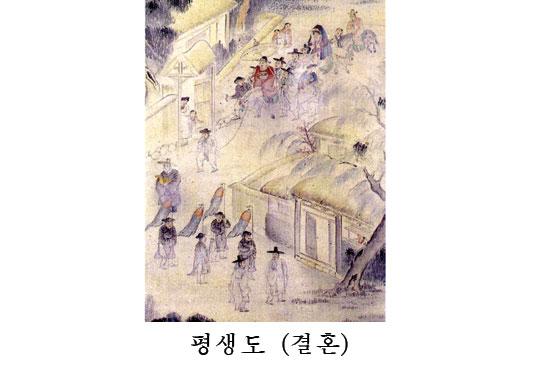Wedding custom
Originally, wedding was celebrated in a simple and wholesome way in Korea.
An ancient history book Puksa said about the wedding of the period of Koguryo as follows. “When a man and woman liked each other, they would be allowed to get married soon. …”
In this way Koguryo people celebrated the wedding in a simple and effective way.
There emerged complicated formalities and procedures of wedding in the period of the feudal Joson dynasty.
Until the late period of the feudal Joson dynasty, the formalities and procedures included an interview with a view to marriage, engagement, fixing a date, sending blue and red silks to the bride’s house (exchanging ceremonial dress), wedding ceremony and the like.
The main ceremony was the wedding.
The bridegroom went to the bride’s house to get married and brought the bride to his house.
The ceremony of a bridegroom followed the procedure of presenting a goose to the bride, exchanging nuptial bows and receiving a wedding table.
Presenting a goose is a ceremony in which the bridegroom presents a goose to the bride’s mother. Exchanging nuptial bows is a ceremony that the bride and bridegroom drink liquor on gourd-shaped cups decorated with blue and red threads.
Then, the bridegroom is presented with a wedding table.
The ceremony of a bride is a wedding ceremony held in bridegroom’s house and it followed procedure of receiving a wedding table, shrine-visiting (bowing to bridegroom’s ancestors) and bowing to parents-in-law.
The relatives and neighbours were invited to the both wedding ceremony of the bride and bridegroom and the guests made wedding gifts to show their good faith.
Wedding dress
It was a general custom to put on samogwandae (hat and dress of public officials) for a bridegroom and chilbodanjang (seven treasures costume) for a bride on a wedding day.
If a bridegroom couldn’t prepare samogwandae, he might put on paji (Korean trousers), jogori (Korean jacket) and turumagi (a Korean overcoat).
Chilbodanjang was the main wedding dress for a bride.
Chilbodanjang is the wedding costume of a bride which includes chilbojokduri (a black crown-like headpiece decorated with seven treasures) and ceremonial dress such as tholbaeja (a woman's fur-lined waistcoat), tangui (full dress of a woman), rasam (an unlined summer jacket), hwalot (women’s ceremonial dress) or wonsam (women’s ceremonial dress).
Chilbo means seven treasures including gold, silver, emerald, beautiful stone like a jewel, agate, amber and coral. A jokturi or a hwagwan decorated with such seven treasures were called as Chilbojokduri and Chilbohwagwan.
Wedding dress varied slightly according to areas.
In Pyongyang and Phyongan Province, the wedding dress of a bride included tahongchima (a Korean red skirt) and a green jogori, tholpaeja, earrings and silver pendent trinket.
In Hamgyong Province, it included tahongchima, yellow samhoejang-jogori (jacket with three ornamental edgings) and rasam or hwalot.
In the central areas, it included yellow or green samhoejang-jogori, tahongchima and hwalot.
In Kaesong, it included light green hoejang-jogori, tahongchima and hwalot.
In the southern areas, it included green or yellow hoejang-jogori with tahongchima and wonsam or tangui.
There were slight differences of outer garments according to areas but it was common for a bride to put on a jokturi (black crown-like headpiece) or hwagwan (a ceremonial coronet) and tanghye (shoes).
Dr. Ri Sun Hui, Researcher of Korean Folklore Museum
